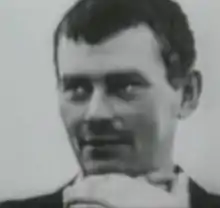Gennady Mikhasevich
Gennady Modestovich Mikhasevich (Belarusian: Генадзь Мадэставіч Міхасевіч; 7 April, 1947 – 25 September, 1987) was a prolific Soviet serial killer. He murdered 33[1] women during the period from 1971 to 1985 in Vitebsk, Polotsk and the rural areas in the nearby regions of the Byelorussian SSR.
Gennady Modestovich Mikhasevich | |
|---|---|
 | |
| Born | 7 April 1947 |
| Died | 25 September 1987 (aged 40) |
| Cause of death | Execution by firing squad |
| Conviction(s) | Murder |
| Criminal penalty | Death |
| Details | |
| Victims | 33 confirmed 43 confessed 55+ estimated |
Span of crimes | 1971–1985 |
| Country | Byelorussian SSR, Soviet Union |
| State(s) | Vitebsk Oblast |
Date apprehended | 9 December 1985 |
Biography
Gennady Mikhasevich was born in the village of Ist (Vitebsk Oblast) in 1947,[2] and served in the army. He committed his first murder in May 1971. He himself later explained that the killing spree started after he had returned from the army only to find out that his girlfriend had left him and gotten married in the meantime. On the night of 14 May, 1971, he was on his way from Vitebsk to Polotsk. It was late so he could not catch a bus to Polotsk where his parents lived. Mikhasevich reported that he was feeling despondent because of the breakup with his girlfriend, and had prepared a loop to hang himself. By chance, however, he encountered a young woman on the road and, in order to vent his anger, decided to kill her. He murdered again in October 1971, and strangled two other women in 1972, near Vitebsk. Mikhasevich graduated from a technical school in Vitebsk in 1973 and returned to Ist, starting work in a sovkhoz. He got married in 1976. In the meantime, the murders went on.
Many of his murders were committed to facilitate rape. He invariably strangled or smothered his victims, either assaulting them in solitary locations or, during later years, after having lured them into his own red Zaporozhets or the cars at his workplace (he later had a job in an auto repair shop). Mikhasevich did not carry weapons, choosing instead to use a variety of improvised means, including in one case, a cord made of rye. Besides killing, he robbed his victims of money and valuable items, some of which he would later present to his wife as a gift. He would also take mundane household items, like scissors.
In outward appearance, Gennady Mikhasevich was a good family man, a teetotaller with two children and was a conscientious worker; he was also a member of the Communist Party (also serving as a local party functionary) and of Voluntary People's Druzhina.
The investigation started to advance in the 1980s, as the young investigator Nikolay Ignatovich firmly believed that all the killings of females near motorways in the region were not separate, isolated cases as previous investigators had conveniently believed, but had in fact been committed by one person, a serial killer. The police also suspected that the serial killer was using a red Zaporozhets; as they started checking all the people of the Oblast who possessed such a car, Mikhasevich, as a druzhinnik, participated in these actions - essentially, searching for himself.[2] This also gave him insight into the investigation itself, enabling him to learn of the steps investigators were taking beforehand, and allowing Mikhasevich to plan his own steps to avoid them. The year 1985 was especially 'prolific' for the murderer: he killed 12 women in this year alone.
Eventually, Mikhasevich, who was now getting concerned, made a fatal mistake. In order to derail the investigation, he sent an anonymous letter to the local newspaper on behalf of an imaginary underground organization, 'Patriots of Vitebsk', purportedly calling on his fellow militants to intensify their struggle of killing communists and lewd women. When he left a similar hand-written note next to his new victim, again signed on behalf of 'Patriots of Vitebsk', the investigators started to ascertain the handwriting of the male residents of the Oblast. Having checked 556,000 samples, the experts detected that the sample with the handwriting of Gennady Modestovich Mikhasevich bore a striking resemblance to the handwriting on the murderer's notes. Further investigation revealed other evidence, convincing them of Mikhasevich's guilt.
He was finally arrested in December 1985, after initial denial, he confessed and was sentenced to death and executed by firing squad in 1987. His case became notorious in the USSR (“The Vitebsk Case” (“Витебское дело”)), as it revealed the incompetence of the police: by the time Mikhasevich was finally arrested, 14 people had already been convicted for the crimes Mikhasevich committed, and a couple of them had been sentenced to death and executed for crimes they did not commit.
Footnotes
- "Archived copy". Archived from the original on 2011-08-30. Retrieved 2013-11-23.CS1 maint: archived copy as title (link)
- Newton, Michael (2006). The Encyclopedia of Serial Killers. Infobase Publishing. p. 177. ISBN 0816069875.